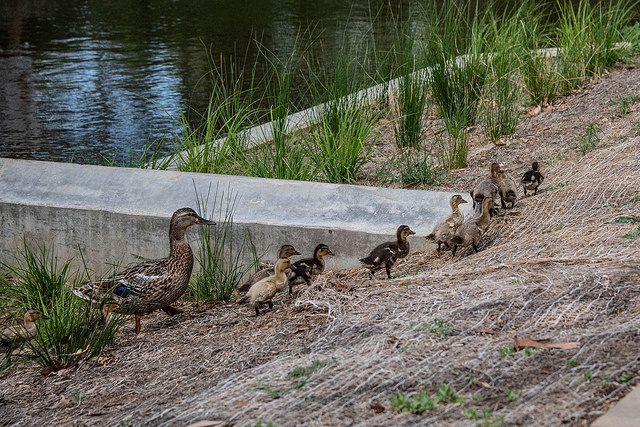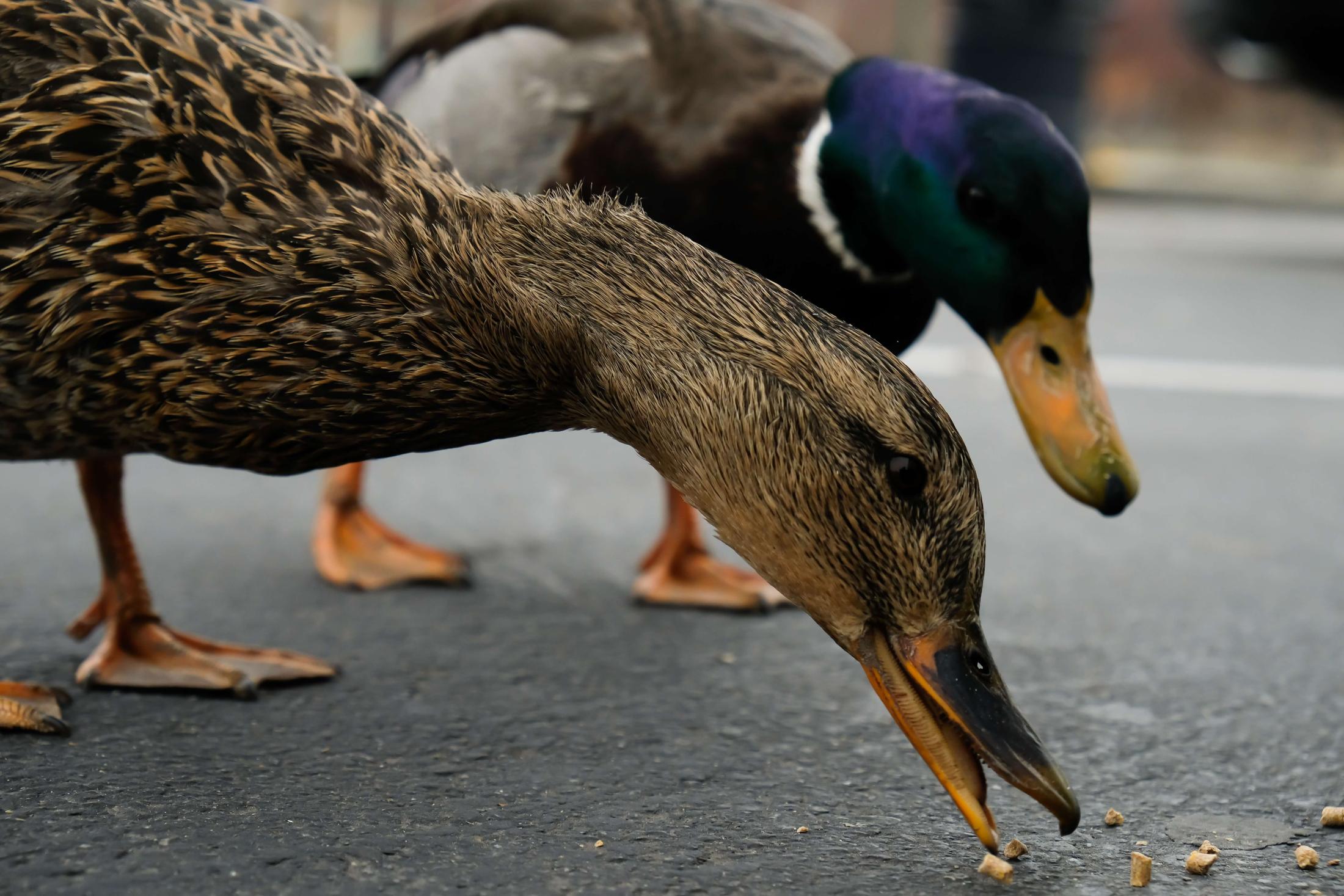Save the Ducks!
by Nina Suzuki, waterway steward
No crackers for quackers - keep waterfowl healthy and wild
Wildlife in the UC Davis Arboretum is part of what makes it a special place. Feeding ducks, or any waterfowl, is not permitted on the UC Davis campus according to the UC Davis Policy and Procedure Manual Sect. 290-90. California state law also reflects this. Section 251.1 of Title 14 of the California Code of Regulations prohibits the harassment of any game or non-game bird or mammal or fur-bearing mammal, expressly including intentional acts such as feeding that disrupt the animal’s natural foraging behavior.
Why not?
Feeding the ducks is a very old and popular family pastime. What many people don’t realize is that feeding wildlife can lead to severe health consequences for wildlife and people. Learn more below.
Table of Contents
- Overcrowding and Disease
- Habitat Degradation
- Nutritional Consequences
- Habituation
- What You Can Do
- References

Overcrowding and Disease
In the wild, a particular lake or pond habitat can sustain a certain number of ducks and/or geese – there is a maximum number of individuals that can successfully reside there indefinitely, with enough food, water, and shelter. This carrying capacity of the habitat can be artificially increased when supplemental food is added.
While extra food may appear to be a good thing, it may lead to an expanded waterfowl population beyond the carrying capacity of the habitat. Without increasing space and other resources, ducks and geese can become stressed and overcrowded. Increased numbers of animals leads to increased competition for food; weaker birds in these environments often sustain severe injuries from more dominant birds. During the spring breeding season, gangs of male ducks physically attack each other to get access to female ducks. This not only leads to plucked featherless areas and skin lacerations, but females often drown as they cannot escape the driven males. Females that manage to escape the male ducks often nest up to a mile away from the water. This abnormal nesting behavior may put them at risk of urban predators, vehicle collisions, and perils not associated with nesting in natural areas.
Overcrowded habitats also are prime territories for disease outbreaks. There have been numerous outbreaks of botulism, avian cholera, duck plague (duck enteritis virus), and aspergillosis (fungal infection) in urban duck ponds where supplemental feeding is a regular activity. The intense competition for poor quality food combined with other stressful interactions often cause the ducks and geese to have suppressed immune systems, which reduces their ability to resist infection.
In some cases, humans have been affected by disease transmitted by waterfowl. The risk of disease transmission is partially due to the fact that large numbers of birds leave large quantities of feces. A single goose can produce up to 1.5 pounds of feces each day. This problem is magnified as these birds have become non-migratory or resident birds due to feeding by humans. Research has shown that the excrement of geese contains a wide variety of pathogens capable of infecting humans. Duck and goose droppings, in particular, might contain germs such as E.coli, Salmonella, Campylobacter, or Cryptosporidium.
For areas with high volumes of supplemental feeding, it’s also quite common for the unconsumed, leftover food to attract scavengers, including raccoons, squirrels, opossums, and rats. Dense populations of these scavengers bring the potential for further disease outbreak, including zoonotic diseases that are transmissible to humans.
Habitat Degradation

There are also environmental issues related to artificially increasing the number of ducks and geese in a given area. Large numbers of waterfowl in a small area can seriously impact the surrounding environment.
Feces generated by overcrowded waterfowl result in increased deposition of carbon, phosphorus, and nitrogen in the water and surrounding landscape. The addition of these nutrients to water (a process known as eutrophication) promotes excessive algae growth, leading to decreased oxygen levels, foul-smelling green and cloudy water, fish kills, and an overall decrease in water quality. Some common algae species (blue-green algae) even produce toxins associated with illness in wildlife, humans, and pets.
Nutritional Consequences
Wild ducks and geese feed on a variety of grains and grasses, aquatic plants, and invertebrates, all naturally found in the wild. When eaten in combination, these foods are nutritionally balanced and provide everything a wild duck or goose needs to survive.
In contrast, foods commonly fed to waterfowl in public parks, such as bread, crackers, popcorn, and corn, are typically low in protein and essential nutrients and minerals (such as calcium and phosphorus). While a single feeding of these “junk foods” may not harm waterfowl, it adds up! If everyone visiting a park “only” gives a few pieces of bread or crackers to ducks and geese, it quickly becomes the bulk of what wild waterfowl consume, and results in a variety of nutritional disorders.
Waterfowl in public parks are often admitted to wildlife rehabilitation centers with metabolic bone disease (MBD). Birds with MBD have incredibly soft bones and joints that are often malformed and fractured; these injuries are caused by an overall calcium deficiency in the body, which is linked to an inappropriate diet. Calcium also plays a crucial role in the formation of eggs/offspring, clotting ability, cardiovascular and neuromuscular function, and a variety of other metabolic activities. Birds with MBD are often so malformed they cannot fly and become dependent on handouts, comp

leting a vicious cycle. Affected birds are typically too weak to compete for food and defend themselves and are often the victims of aggressive attacks by other ducks and geese.
Another common issue with ducks and geese in public parks is “angel wing” -- a condition where the ends of an affected bird’s flight feathers are twisted upward. “Angel wing” occurs when ducks and geese grow abnormally quickly; the affected birds’ joints don’t fully form as the wing and feathers develop and the weight of the growing feathers rotates the tip of the bird’s wing. If caught in initial stages, waterfowl suffering from this condition may be treated with splints to guide bone growth in the correct position. Although there are several theories regarding the causes of “angel wing”, some studies suggest that diets high in protein may be to blame. Well-meaning people feeding commercial duck, chicken, or turkey feed to avoid the “junk food” may be unintentionally creating this disorder.
One more problem with bread products is that this type of food expands in water -- and the stomach -- which gives ducks and geese an artificial feeling that they are full. As a result, these birds may not feel motivated to continue foraging on natural foods of higher nutritional value.
Habituation
In the wild, a healthy fear of humans and other potential predators allows ducks and geese to survive and reproduce. In public settings where waterfowl are fed artificial diets, these birds often lose this fear and are more likely to be consumed by predators (feral cats, dogs, foxes, raccoons, etc). Urban waterfowl may also be more likely to be hit by vehicles, entangled in litter, and maliciously harmed by humans. Habituated geese can pose a significant public health threat at certain times of the year if they are defending a nesting female or a brood of goslings. These habituated geese have the ability to seriously hurt humans, particularly children.
What You Can Do
Allowing ducks and geese to find their own wild, nutritionally balanced diet is best – for the health of waterfowl and the surrounding environment. The bottom line is that wild ducks and geese are able to find plenty of food on their own – so resist the temptation to feed, simply pack your binoculars and camera and enjoy watching the birds.
Spread the word! Share this information with others. We can all do our part to protect wildlife.
References
- California Code of Regulations
- Wildlife Center of Virginia
- California Centers for Disease Control and Prevention

